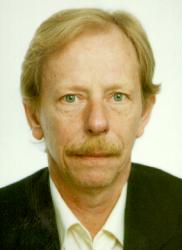




















Björn Olof ROOS
(1937-2010)

Professor Roos' contributions to theoretical chemistry were foundational at the most fundamental level: each of his developments opened some broad new area of chemistry that had hitherto seen little successful theoretical study. Professor Roos' models continue to be put to practical use every day in modern calculations, and in many cases continue to be the benchmark calculations against which new model developments are measured.
Professor Roos began his studies of quantum chemistry just as the community was beginning to recognize the potential for digital computers to assist in the solution of the complex numerical problems associated with solution of the Schrdinger equation for molecular systems. His first major breakthrough was the development of the direct configuration interaction (CI) method in 1972. In a particularly clever insight, Professor Roos recognized that the very expensive formation and diagonalization of the CI matrix could be replaced by an iterative procedure involving only the two-electron repulsion integrals already available from an antecedent Hartree-Fock (HF) calculation. This algorithmic advance reduced the time required for a typical CI calculation by one to two orders of magnitude for a typical molecular system. Early applications of this paradigm- shifting approach included the determination of the bond energy in the water dimer with an accuracy of better than 1 kcal/mol, the identification of hydrogen isocyanide (HNC) in interstellar space through comparison to its computed rotational spectrum, and the calculation of the energy surface for H3 with an accuracy of 0.1 kcal/mol (the latter work involved Roos' then student, Per Siegbahn, now Professor at Stockholm University).
Professor Roos' next key development came in 1980, when he and his co-workers described the complete active space self-consistent field (CASSCF) method. Prior to this point, theoretical studies had focused predominantly on closed-shell singlets and other electronic states readily described by single determinants. The CASSCF model, however, was completely general and opened the way to even-handed treatment of all types of electronic structures, independent of open shell character, spin multiplicity, etc. Thus, using the CASSCF model, it became possible to generate accurate potential energy surfaces across regions of bond making and bond breaking (i.e., to study chemical reactions) and also to rigorously describe excited molecular electronic states. The CASSCF method continues to be one of the most important standard tools in quantum chemistry for the calculation of complex molecular properties in both ground and excited states of molecular systems. Indeed, it is still the only method which can be used for the general treatment of excited-state potential energy surfaces (photochemistry) although newly developed models based on time-dependent density functional theory are beginning to show promise. Professor Roos has recently extended the CASSCF model to permit spin-orbit coupling between different electronic states. The combination of this model with a Douglas-Kroll-Hess Hamiltonian (to account for scalar relativistic effects) has led to an explosion of activity in the application of the CASSCF model to lanthanide and actinide compounds, including a fascinating paper in Nature in 2005 that addressed the unique bonding in the U2 dimer and led to a renaissance of interest in the fundamental nature of the chemical bond.
In typical application, the CASSCF method treats only the so-called nondynamical part of the electron-electron correlation problem. The missing part (dynamical correlation) can be treated using a multireference (MR) variation of Roos' direct CI, but such a direct MRCI can only be practically undertaken for very small molecules. Recognizing this limitation, Roos contributed yet another fundamental methodological advance and developed over the course of the 1980s a multireference perturbation theory for computing the electron correlation energy: CASPT2. The CASSCF/CASPT2 model has proven to be remarkably accurate and robust, making it the model of choice for the study of many reactions and, particularly, for the study of photochemistry and excited-state reactivity. In the absence of an experimental measurement, the typical benchmark for an excited-state energy would be a CASPT2 calculation. One measure of the utility and popularity of the CASSCF/CASPT2 model is the degree to which it has been coded into the most widely used electronic structure program suites, including the one developed by Professor Roos himself, MOLCAS, which has a user base of hundreds of research groups.
Professor Roos' approach to quantum chemistry was always to develop methods which could be used in large-scale applications to real chemical problems. He and his co-workers demonstrated the scope of his methodologies in pioneering applications, e.g., characterizing the spectroscopic properties of the blue copper proteins (which led to a new understanding of the concept of strain in biochemistry), describing the electronic spectra of numerous organic molecules, including the DNA and amino acid chromophores, and studying the chemical bonds in transition-metal compounds (to include the only successful description to date of the chemical bond in Cr2). As noted above, particularly recent applications have focused on the heaviest elements in the periodic table, including studies of the dynamics of the uranyl ion in water, and the characterization of complexes of uranyl and neptunyl with carbonate and water (relevant to the reprocessing of spent nuclear fuel). Key to several of these studies ws also Roos' development of especially well balanced basis sets for all-electron calculations, and recent and important developments using Cholesky decomposition to speed integral evaluation.
The methodological developments pioneered by Professor Roos dramatically and uniquely advanced wave-function theories in quantum chemistry. The influence of the direct CI, CASSCF, and CASPT2 models on modern quantum chemistry have been profound, particularly in the degree to which they have permitted the extension of accurate theoretical models to enormous swaths of the periodic table that had been previously inaccessible. This is a testament to the creativity and vision of Professor Roos, who repeatedly combined an appreciation for chemical relevance with brilliant physical and algorithmic insights.

